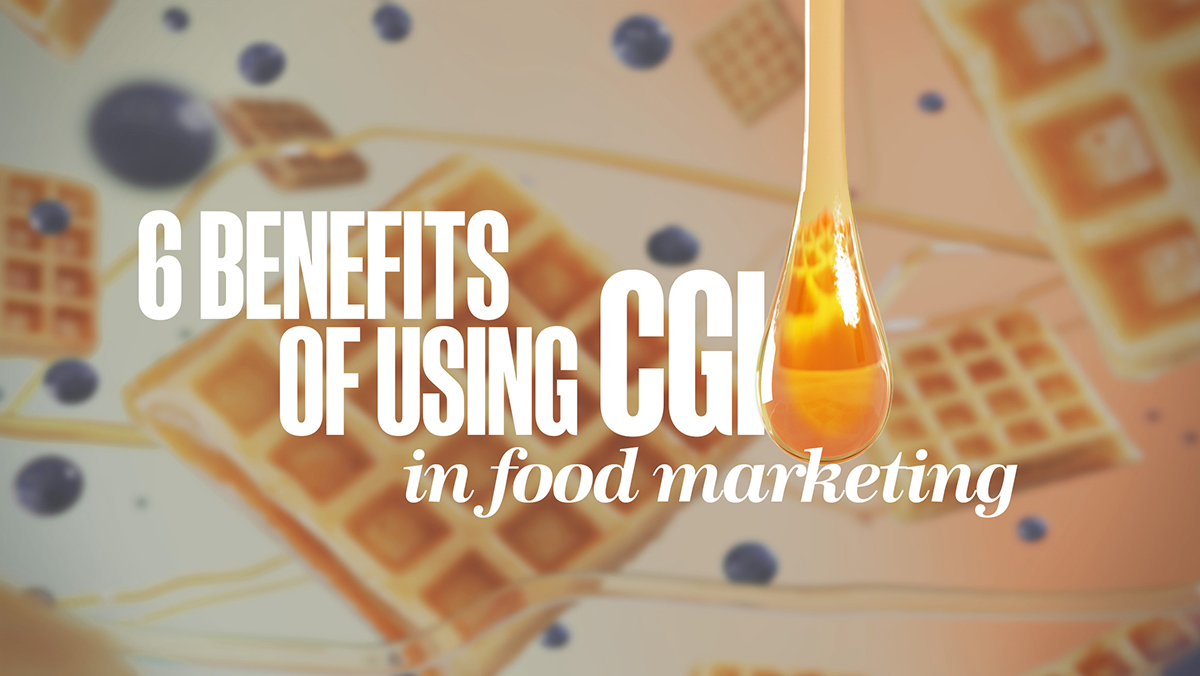CGI foodography: the secret ingredient to your marketing mix?
Posted by: Fiona Barber - 12.06.23
From juicy burgers to seductive ice creams and flawless fruit and veg, delicious and realistic food CGI (computer generated imagery) product shots are everywhere. Now a staple tool in advertising and marketing, CGI ‘foodography’ is transforming the way brands showcase their products creatively and innovatively.
There are still many scenarios where stunning traditional food and drink photography can’t be beaten but there are plenty of pros of CGI. It allows us to generate otherwise impossible food imagery and push creative boundaries to the limits.
In this blog we’ll look at the benefits of using CGI to create food asset libraries, TV ads or packshot visuals, plus find out from our CGI experts how it’s done.
Benefits of using CGI in food advertising
- Be fresh and consistent, every time
Preparing food to an exact specification and hoping it will stay intact for the shot can be risky and unpredictable. Ice cream is an ideal product to create in CGI. Avoid any melting disasters, and the need for dyed scoops of mash potato – plus the texture of ice cream lends itself well to CGI.
When detail and exact execution are essential, CGI can simplify pre-production logistics and save valuable time and money on crew members and preparing perishables.
2. The ingredients for multi-market advertising
CGI makes it easy to update packaging artwork and alter a product image’s texture, colour, and style – making it easy to tailor changeable imagery for a multi-market or territory approach.
3. Feed your creativity
CG images offer next-level creative freedom and flexibility that traditional photography simply can’t match. Bend the rules of photography reality; create a landscape of 10,000 cupcakes if you wish. We can make your food dreams become reality – whatever that might look like.
It allows brands to showcase their products in unique and interesting ways without the constraints of real-world limitations.
4. Extend your assets’ shelf life
The ability to archive, easily revisit and refresh CGI shots ensures your lettuce stays fresh and doughnuts are always glazed.
Due to the virtual world of CGI, once a shoot is complete we can return to the virtual photoshoot at any time to change the colour and flavours of your best sellers. This builds brand and range consistency as well as improving speed to market and reduced creative costs.
5. Try before you buy
Got a new product to introduce to market that’s not quite ready? Fancy trialling a new idea you’re not too sure about? Or have a limited edition product to promote? Through modelling, CGI offers food brands the chance to visualise and market products for feedback before they’ve even been manufactured.
6. Make your ingredients work harder
Once you have a bank of 3D CGI assets, they can be used across a broad range of platforms such as AR and VR. This opens up the potential of creating an interactive experience with your product and brand.
Once we have set up an environment, we can easily replicate and replace elements such as props, garnishes, side dishes, and even the plates and cutlery, which is an effective way to produce large volume variants of product combinations. Check out our modular content tool FUSE – personalised content for every territory and demographic on your marketing plan.
Creating CG food shots isn’t just for food brands. It can also be used to create tasty looking props in lifestyle shots to make scenes feel more realistic, demonstrate products in use, adding a tangible quality and realism that people can relate to.
Chris Heeley, Digital Production Director

The above fully rendered lifestyle image for Modex created by Ride Shotgun demonstrates the flexibility of the product in a relatable homely setting and the use of CGI food props means the CGI team can easily alter angles and compositions to set up alternative angles/detail shots and additional shots for packing.
CGI food imagery so good you can almost taste it


We make it look easy, but there’s a lot of work and a dash of magic that goes into creating delectable, photorealistic CGI food images. Here’s how we do what we do.
Our team can model a product from scratch, working from supplied references and dimensions, or alternatively, we can use photogrammetry. Photogrammetry is the process of scanning an object, capturing every detail from a variety of angles and stitching the image together to create a 3D model of the object. Using photogrammetry our CGI team can create a 3D asset of a delicious meal.
For example, to create the below waffle in 3D, we use photogrammetry to scan the organic shape, visually capturing every detail from all angles and stitching the images together to create the 3D model of the food. Once processed by our in-house CGI artists, this detailed replica can be multiplied and manipulated to your heart’s content.

Ready to ride?
The CGI team is made up of stylists and CGI photography artists collaborating to create perfectly lit and propped compositions. We blend art and science, architects and interior designers with 3D artists and modellers to create drool-worthy content that captures audiences and drives engagement.
Looking for an agency that can cost-effectively boost your marketing with added strategy, creativity and activation?
